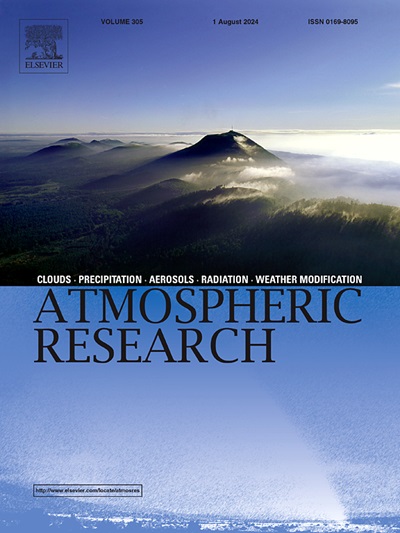The effect of stratus clouds on aerosol distribution in South China based on aircraft measurements
IF 4.4
2区 地球科学
Q1 METEOROLOGY & ATMOSPHERIC SCIENCES
引用次数: 0
Abstract
To study the distribution characteristics of aerosols and clouds in South China under the influence of typical weather systems such as the southern trough, this paper analyzed the distribution and sources of aerosols and cloud droplets based on six flight observations conducted in Guangdong during the spring of 2024. The results indicated that aerosol number concentrations often peak above cloud tops or in the regions between two cloud layers. The average aerosol number concentration outside the clouds at high altitudes (2000–4100 m) ranged from 501 to 1617 cm−3, while in the near-surface layer it was 970 to 2168 cm−3, with an effective diameter averaging 0.27 to 0.5 μm. The concentration inside the clouds significantly decreased, and the diameter increased. The aerosol particle spectrum displayed a bimodal distribution, with peaks at 0.15 μm and 0.29 μm. The number concentration of particles smaller than 0.3 μm within the clouds declined, while the proportion of particles larger than 0.5 μm increased. The cloud droplet spectrum displayed a multimodal distribution, with the main peak occurring at a diameter of around 5 μm and secondary peaks found at diameters in the range of 10 to 16 μm. As the cloud layer thickened, the droplet spectrum broadened, large droplet concentrations increased, and small droplet concentrations decreased. Under the influence of non-precipitating stratus clouds in South China, the average aerosol scavenging efficiency was 0.47. The mean cloud droplet number concentration, liquid water content, and effective diameter were 67.3 cm−3, 0.02 g·m−3, and 9.4 μm, respectively. Long-range transport originating from South Asia and Southeast Asia is suggested as a potential contributing factor to the elevated high-altitude aerosol concentrations. The research findings deepen the understanding of cloud and aerosol microphysical characteristics in the South China region. This contributes to the evaluation of climate models and provides guidance for artificial weather modification operations.
基于飞机测量的华南地区层云对气溶胶分布的影响
为研究南方低槽等典型天气系统影响下华南地区气溶胶和云的分布特征,利用广东省2024年春季6次飞行观测资料,分析了华南地区气溶胶和云滴的分布及来源。结果表明,气溶胶数浓度往往在云顶以上或两层云层之间的区域达到峰值。高海拔(2000 ~ 4100 m)云外气溶胶数浓度平均值为501 ~ 1617 cm−3,近地面气溶胶数浓度平均值为970 ~ 2168 cm−3,有效直径平均值为0.27 ~ 0.5 μm。云内浓度显著降低,直径增大。气溶胶粒子谱呈双峰分布,峰位于0.15 μm和0.29 μm。云内小于0.3 μm的颗粒数量浓度下降,大于0.5 μm的颗粒比例增加。云滴光谱呈现多峰分布,主峰出现在直径约5 μm处,次峰出现在直径10 ~ 16 μm处。随着云层的增厚,液滴光谱变宽,大液滴浓度增加,小液滴浓度降低。在华南非降水层云影响下,平均气溶胶清除效率为0.47。平均云滴数浓度为67.3 cm−3,液态水含量为0.02 g·m−3,有效直径为9.4 μm。来自南亚和东南亚的远距离输送被认为是造成高空气溶胶浓度升高的一个潜在因素。研究结果加深了对华南地区云和气溶胶微物理特征的认识。这有助于气候模式的评估,并为人工影响天气作业提供指导。
本文章由计算机程序翻译,如有差异,请以英文原文为准。
求助全文
约1分钟内获得全文
求助全文
来源期刊

Atmospheric Research
地学-气象与大气科学
CiteScore
9.40
自引率
10.90%
发文量
460
审稿时长
47 days
期刊介绍:
The journal publishes scientific papers (research papers, review articles, letters and notes) dealing with the part of the atmosphere where meteorological events occur. Attention is given to all processes extending from the earth surface to the tropopause, but special emphasis continues to be devoted to the physics of clouds, mesoscale meteorology and air pollution, i.e. atmospheric aerosols; microphysical processes; cloud dynamics and thermodynamics; numerical simulation, climatology, climate change and weather modification.
 求助内容:
求助内容: 应助结果提醒方式:
应助结果提醒方式:


